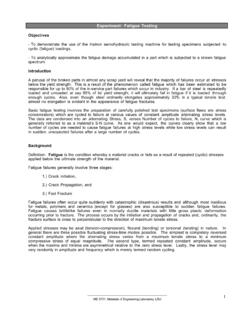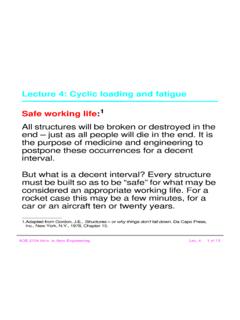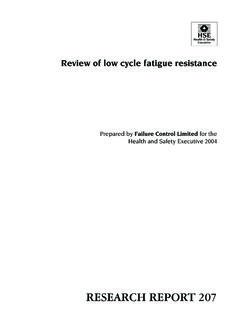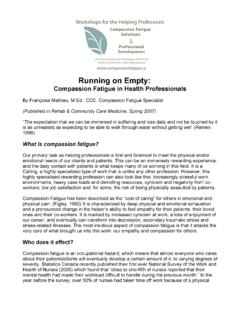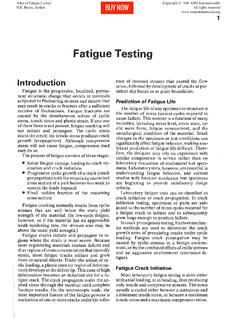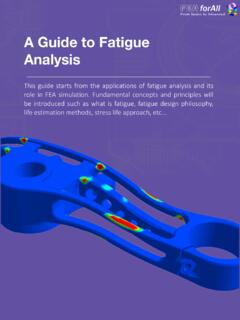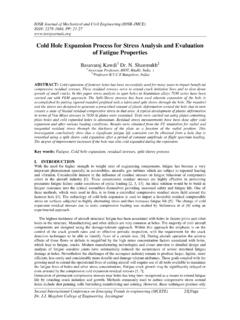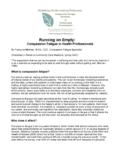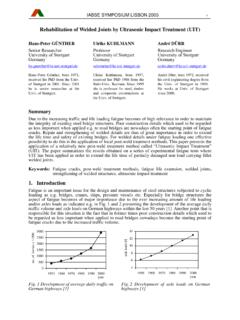Transcription of Volume 2 - Fatigue Theory Reference Manual
1 Safe technology limitedVol. 2 ContentsIssue:1 2 Contents 1 Volume 2 Fatigue Theory Reference ManualContents1 Introduction to of the applied Fatigue factors which influence Fatigue strain- life Fatigue stress and life stress -strain response to a sequence of of mean local strain Smith-Watson-Topper of stress nominal strain strain analysis from a cycle of cast of local strain of strain- life strain materials cyclic stress - strain strain- life for other testing for cast of materials processing for Fatigue cycle crossing and valley analysis using stress - life (S-N) of stress load of Fatigue safety safe technology limitedVol. 2 ContentsIssue:1 2 Contents to other of S-N strength reduction work on notch sensitivity and the effects of stress and strain yield Fatigue using equivalent stress or plane of mean of strain-based Van of Fatigue - life analysis from Finite Element of Finite Element a linear elastic model with single applied load a linear elastic model with multiple applied a sequence of data types of of statistics in Weibull probability in purpose of fracture at the crack stresses at the crack corrosion safe technology limitedVol.
2 2 ContentsIssue:1 2 Contents 311 Fatigue of welded steel life of applied of mean of material of probability of Fatigue and further analysis from the Fatigue analysis from PSD's?.. methods of Fatigue analysis from the of rainflow ranges from a test signals and cumulative amplitude loading test signals to remove small of larger test of in-company test Fatigue strain term recording or long term analysis safe technology limitedVol. 2 ContentsIssue:1 2 Contents 4 Introduction to Fatigue 1 Introduction to Fatigue Introduction Fatigue cracks are caused by the repeated application of loads which individually would be too small to cause failure. Fatigue cracks usually initiate from the surface of a component (Figure ). This is crack initiation.
3 The crack may then propagate in a direction perpendicular to the direct stress . This is crack propagation. Finally the component may fracture. InitiationPropagationFractureSurface Figure The three stages of Fatigue failure Modern Fatigue theories provide separate analyses for each phase. Crack initiation theories are based on the assumption that Fatigue cracks are initiated by the local strains and stresses on the surface of a component. Crack propagation theories relate crack growth to the stresses in the component. Final fracture is analysed using fracture mechanics. Earlier theories treated the whole of the Fatigue life as a single entity, and related Fatigue life to the calculated engineering stresses in the component. Much current research is attempting to describe the whole Fatigue process by the study of crack propagation from very small initial defects.
4 Figure shows a Fatigue fracture from a shaft which was tested in bending. Crack initiation has occurred from the surface (at the top of the picture). The progress of the crack is shown by the bands - called striations, or beach marks - which occupy most of the fracture face, with a small area of brittle fracture at the bottom of the picture. Figure Fatigue fracture surface from a shaft in bending safe technology limited Vol. 2 Section 1 Issue: 1 Date: Volume 2 1-1 Introduction to Fatigue An early example of testing to determine the Fatigue strength of a component was reported by Albert in 1838. He investigated the Fatigue failure of chains used to haul trucks in mine shafts (Ref ). Examples of the chains were tested using a purpose-built test rig (Figure ).
5 The weight was raised and lowered, applying repeated loads to the links of the chain. Figure Time history of applied loading on the chain If a new chain is used for each test, and each chain is tested using a different load, the relationship between the magnitude of the applied load and the number of applications to cause fracture of the chain, can be plotted (Figure ). The horizontal axis shows the number of load applications required to cause failure. This is the life of the chain, and is referred to as the endurance. It is always plotted on a log10 axis. The vertical axis shows the magnitude of the applied load. Figure Fatigue test results Description of the applied loading Figure Terms used to describe Fatigue loading The following terms are used to describe Fatigue loading maximum load = Pmax minimum load = Pmin safe technology limited Vol.
6 2 Section 1 Issue: 1 Date: Volume 2 1-2 Introduction to Fatigue load range P = Pmax - Pmin load amplitude Pa = P2 (also called alternating load) mean load Pm = Pmax + Pmin2 load ratio R = PminPmax amplitude ratio A = PaPm One application of the load is called a Fatigue cycle. The loading used in the chain tests is constant amplitude loading because each cycle has the same load amplitude. Commonly used load ratios in Fatigue testing are R = 0 where the minimum load is zero, and R = -1 where the minimum and maximum loads are equal and opposite and the mean load is zero. Figure Fatigue loading at a load ratio R = 0 And R = -1 Endurance curves Endurance curves are plotted with cycles to failure on the horizontal axis and load amplitude on the vertical axis.
7 If log10 scales are used for both axes, the load- life relationship will approximate to a straight line over a large range of endurance, for many components. Load Amplitude PaEndurance limitCycles to failure Nf Figure Example of an endurance curve safe technology limited Vol. 2 Section 1 Issue: 1 Date: Volume 2 1-3 Introduction to Fatigue For steels there may be an endurance limit at around 107 cycles, implying that cycles with amplitudes smaller than the endurance limit load will not cause Fatigue failure, however many times they are applied. Endurance limits are discussed in Chapter 13. Generalising Fatigue data An endurance curve which relates load amplitude to endurance for a specific component is not particularly useful - it becomes invalid if the shape of the component is changed, for example.
8 Fatigue endurance curves are generalised to make them more widely applicable. There are three main areas of generalisation : To allow constant amplitude endurance curves to be used to analyse complex load histories To allow endurance curves obtained from smooth specimen tests to be used with different shapes of component To allow an endurance curve obtained by testing one material to be used to calculate Fatigue lives for another material - and if possible to estimate Fatigue properties of a material without performing Fatigue tests . Analysis of complex signals The endurance curve in Figure shows the number of applications of a constant amplitude loading which are required to cause failure of the component. Real components are not usually subjected to constant amplitude loading in service.
9 Practical Fatigue analysis requires a method of calculating the Fatigue life for components which are subjected to variable amplitude loading. Figure Load history with two blocks of constant amplitude loading Figure shows a load history consisting of two blocks of constant amplitude loading. It is assumed that the load history will be repeated until the component fails. If the loading consists of only the larger amplitude Pa1, failure of the component will occur when the number of cycles applied (n1) equals the number of cycles to failure (N1) obtained from the endurance curve, ignoring any scatter in test results. Figure Endurance for the larger load amplitude safe technology limited Vol. 2 Section 1 Issue: 1 Date: Volume 2 1-4 Introduction to Fatigue Clearly, the ratio n1N1 has a value of at failure.
10 Similarly, if the loading consists only of the smaller amplitude Pa2, failure will occur when the number of cycles applied (n2) equalled the number of cycles to failure (N2) obtained from the endurance curve for this amplitude. Figure Endurance for the smaller load amplitude The ratio n2N2 also has a value of at failure. To calculate the life for the combined loading, it was proposed that if, for either amplitude on its own, failure occurs when nN = 1, then for the combined signal, failure will occur when n1N1 + n2N2 = 1 and for more complex loading, with many different amplitudes, failure will occur when nN = 1 ( ) This relationship was first proposed by Palmgren and later by Miner, and is the Palmgren-Miner Cumulative Damage Hypothesis, or Miner s Rule (Ref ).
